
Course list: http://www.c-jump.com/bcc/
Hard Drive =
tracks 0, 1, 2, 3, ...
segments: sectors 1, 2, 3, ...
Cluster =
smallest unit of storage on disk; contains 1 or more sectors
First Sector =
Master Boot Record, the MBR.
If hard drive is listed as the boot device, the BIOS looks for the MBR.
MBR maintains information about the physical hard drive structure:
total number of sectors
number of sectors per cluster
etc.
MBR also contains
Boot Program Code
Partition Table
Master Boot Record (MBR) is found on each physical disk on sector 1, contains:
Boot Code (Program)
Partition Table: can have up to 4 partitions (one extended)
|
|
|
Most commonly found partition type on Intel IA32 hardware (i.e., 16- and 32-bit i386/x86 architecture)
A lot of documentation but no standard reference...
...commonly called Master Boot Record (MBR) partition system
Intel IA64 hardware (i.e., 64-bit Itanium) uses Globally Unique Identifier (GUID) Partition Table (GPT) format
The MBR occupies the first 512 B sector
Contents include boot code, partition table, and signature
Partition table can address up to four partitions
Each table entry includes type of partition and location on the medium

(*) See partition types document for list of PC partition codes.

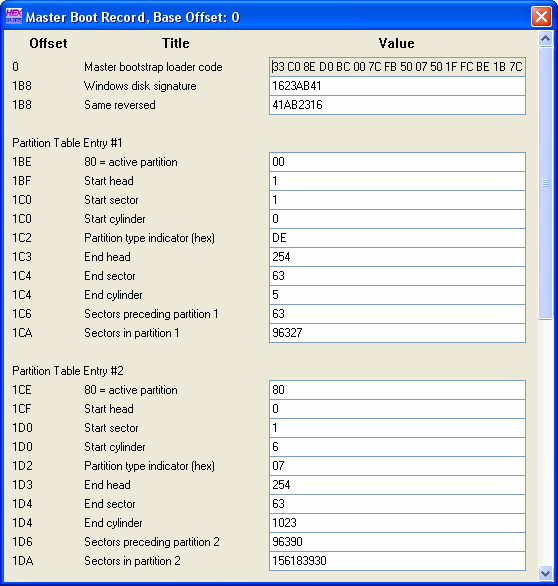
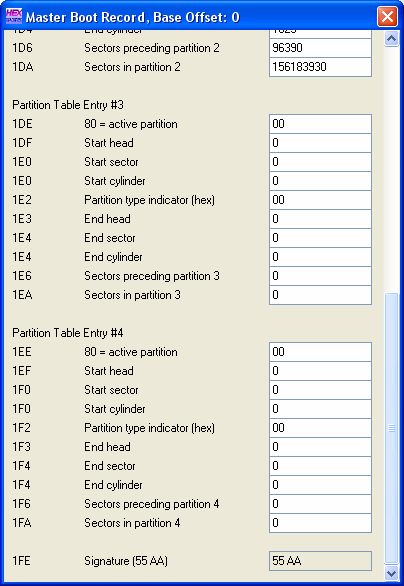

The boot code (located in bytes 0-445 of the MBR) processes the partition table and identifies which partition to boot from.
First sector in active (bootable) partition is the boot sector, which has the next step of the boot information.
Boot sector code is, therefore, operating system-specific.
Handling multiple operating systems
Windows lets MBR execute and point to Windows bootable code, which lets users select OS
Can also replace the MBR boot code to provide the user with a list of choices (e.g., LILO)
If more than four partitions are required, the fourth table entry points to a Primary Extended Partition (PEP)
MBR points to three Primary File Systems plus the PEP
PEP points to a Secondary File System and a Secondary Extended Partition (SEP)
SEP points to additional Secondary File System or Secondary File System/Extended Partition pair
Extended partitions essentially form a linked list to all of the needed file systems
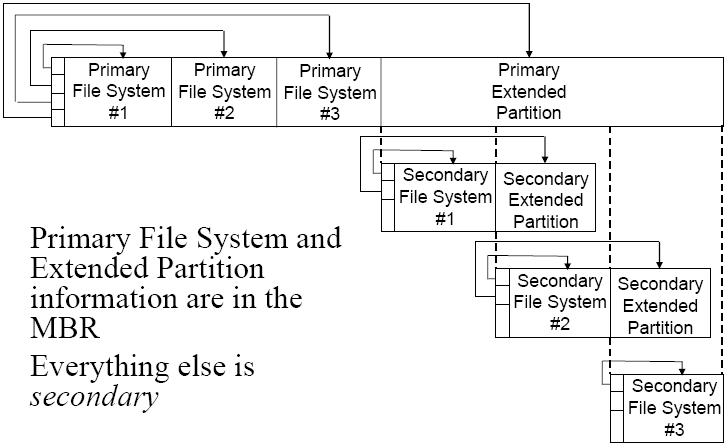
Drive letters are unique to DOS and Windows
Drive letters will only be assigned to recognizable file systems
Not all file systems are known to all OSes...
...which provides a way to hide a partition on a disk...
Drives A: and B: are reserved for floppy disks
Letters C: through Z: may be assigned.
Knowing this is particularly useful when configuring a DOS/Windows system. For example, a user workstation will probably have
its own system hard drive,
another drive for user data, and
possibly more drives for data and backups.
Letters are assigned in the following order:
First primary partition on the drive(s)
Preference given to the active partition, if there is one.
Logical drives in the Primary Extended Partition(s), if present, in the order of physical location on the drive.
Remaining primary partitions, in order found in MBR.
Peripheral devices, such as CD-ROM, DVD, and thumb drives.
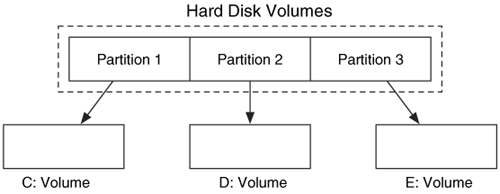

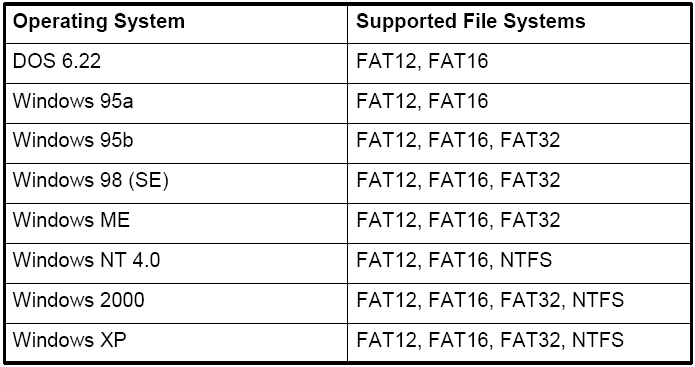
The first OS used by IBM computers/compatibles
Where DOS can still be found:
Specialized systems using older applications
On troubleshooting floppy disks or CDs
DOS is the OS of Windows 3.x:
Windows 3.x provided a graphical interface
Underlying OS functions were performed by DOS
Windows 9x/Me uses DOS in the underlying OS
Windows XP/2000 run DOS emulation programs
Refers to Windows 95, Windows 98, Windows Me
Combine a DOS core with graphical user interface, GUI
Designed to bridge legacy and newer technologies
Backward-compatible with older systems
Cautionary note on minimum requirements -
see Minimum and Recommended System Requirements for details.
Comprises a class of operating systems
UNIX versions referred to as flavors or distributions
FreeBSD
NetBSD
OpenBSD
Sun Solaris
Chief uses:
Controlling networks
Supporting Internet-based applications
Variation on UNIX created by Linus Torvalds
OS kernel and source code are freely distributed
Popular distributions:
RedHat www.redhat.com
TurboLinux www.turbolinux.com
Used as both a server and a desktop
X Windows: GUI shells for UNIX and Linux
Jointly developed by IBM and Microsoft
Chiefly used in certain types of networks
Part of OS/2 was incorporated into Windows NT
OS/2 is not covered in our course
First introduced in 1984 with Macintosh computers
Current version: Mac OS X (ten)
Mac OS X can work on Intel-based computers
Growing Markets: education, desktop publishing, graphics
Noteworthy features:
Support for graphics and multimedia capabilities
Use of the Finder program to provide the desktop
Superior Plug and Play capabilities
Excellent support for multitasking
Mac OS X desktop is intuitive and easy to use
Mac OS uses a single Partition Map in sector 0 to point to all partitions on drive
Partition Map indicates its own size
Mac firmware processes the partition map, so that sector 0 does not contain boot code.
Different systems use even other partition types, including these common systems
FreeBSD
NetBSD
OpenBSD
Sun Solaris
GPT: GUID Partition Table
Guid Partition Table (GPT)
The 64-bit Intel Itanium processors do not have a BIOS like 32-bit systems.
They have a Extensible Firmware Interface.
The EFI uses a partition system called the GUID partition Table that can support up to 128 Partitions and uses 64-bit LBA addresses.
A GPT disk has five major areas:
First area is the Protective MBR:
starts in the first sector of the disk (sector-0)
contains one DOS partition
Second part starts at sector-1 and contains the GPT header. The header defines the size and location of the partition table.
Third section contains the partition table. Each entry contains a starting and ending address.
Fourth section is the partition area:
it is the largest area
contains sectors allocated to the partitions (logical disk volumes.)
Fifth and final section of the disk contains a backup copy of the GPT header and partition table:

GPT partitions are not frequently encountered during investigations. Forensic analysis tools are catching up on fully supporting the GPTs.
Four functions common to all operating systems:
Providing a user interface
Managing files
Managing applications
Managing hardware
All OSs have similar core components
Computer protection and security is based on core OS capabilities
Hard drives are organized into partitions
Two types of partitions:
Primary: can only have one logical drive; e.g., C:\
Extended: can have one or more logical drives
Logical drive (sometimes called a volume):
Formatted using a particular file system
Has a root directory and subdirectories
Disk Management tools:
create/view partitions
format logical drives